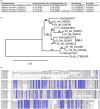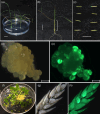CRISPR/Cas9-mediated tetra-allelic mutation of the 'Green Revolution' SEMIDWARF-1 (SD-1) gene confers lodging resistance in tef (Eragrostis tef)
- PMID: 35560779
- PMCID: PMC9398311
- DOI: 10.1111/pbi.13842
CRISPR/Cas9-mediated tetra-allelic mutation of the 'Green Revolution' SEMIDWARF-1 (SD-1) gene confers lodging resistance in tef (Eragrostis tef)
Abstract
Tef is a staple food and a valuable cash crop for millions of people in Ethiopia. Lodging is a major limitation to tef production, and for decades, the development of lodging resistant varieties proved difficult with conventional breeding approaches. We used CRISPR/Cas9 to introduce knockout mutations in the tef orthologue of the rice SEMIDWARF-1 (SD-1) gene to confer semidwarfism and ultimately lodging resistance. High frequency recovery of transgenic and SD-1 edited tef lines was achieved in two tef cultivars by Agrobacterium-mediated delivery into young leaf explants of gene editing reagents along with transformation and regeneration enhancing morphogenic genes, BABY BOOM (BBM) and WUSCHEL2 (WUS2). All of the 23 lines analyzed by next-generation sequencing had at least two or more alleles of SD-1 mutated. Of these, 83% had tetra-allelic frameshift mutations in the SD-1 gene in primary tef regenerants, which were inherited in subsequent generations. Phenotypic data generated on T1 and T2 generations revealed that the sd-1 lines have reduced culm and internode lengths with no reduction in either panicle or peduncle lengths. These characteristics are comparable with rice sd-1 plants. Measurements of lodging, in greenhouse-grown plants, showed that sd-1 lines have significantly higher resistance to lodging at the heading stage compared with the controls. This is the first demonstration of the feasibility of high frequency genetic transformation and CRISPR/Cas9-mediated genome editing in this highly valuable but neglected crop. The findings reported here highlight the potential of genome editing for the improvement of lodging resistance and other important traits in tef.
Keywords: BABY BOOM; Eragrostis tef; SEMIDWARF-1; WUSCHEL; CRISPR/Cas9; lodging.
© 2022 The Authors. Plant Biotechnology Journal published by Society for Experimental Biology and The Association of Applied Biologists and John Wiley & Sons Ltd.
Conflict of interest statement
The authors declare no conflicts of interest.
Figures







Similar articles
-
Semi-dwarfism and lodging tolerance in tef (Eragrostis tef) is linked to a mutation in the α-Tubulin 1 gene.J Exp Bot. 2015 Feb;66(3):933-44. doi: 10.1093/jxb/eru452. Epub 2014 Nov 15. J Exp Bot. 2015. PMID: 25399019 Free PMC article.
-
High-throughput discovery of mutations in tef semi-dwarfing genes by next-generation sequencing analysis.Genetics. 2012 Nov;192(3):819-29. doi: 10.1534/genetics.112.144436. Epub 2012 Aug 17. Genetics. 2012. PMID: 22904035 Free PMC article.
-
Engineering high yield basmati rice by editing multiple negative regulators of yield.Mol Biol Rep. 2025 Jun 4;52(1):545. doi: 10.1007/s11033-025-10660-7. Mol Biol Rep. 2025. PMID: 40464988
-
CRISPR/Cas systems: opportunities and challenges for crop breeding.Plant Cell Rep. 2021 Jun;40(6):979-998. doi: 10.1007/s00299-021-02708-2. Epub 2021 May 11. Plant Cell Rep. 2021. PMID: 33977326 Review.
-
CRISPR-Based Genome Editing: Advancements and Opportunities for Rice Improvement.Int J Mol Sci. 2022 Apr 18;23(8):4454. doi: 10.3390/ijms23084454. Int J Mol Sci. 2022. PMID: 35457271 Free PMC article. Review.
Cited by
-
Biggest of tinies: natural variation in seed size and mineral distribution in the ancient crop tef [Eragrostis tef (Zucc.) Trotter].Front Plant Sci. 2024 Dec 12;15:1485819. doi: 10.3389/fpls.2024.1485819. eCollection 2024. Front Plant Sci. 2024. PMID: 39726428 Free PMC article.
-
Grain shattering by cell death and fracture in Eragrostis tef.Plant Physiol. 2023 May 2;192(1):222-239. doi: 10.1093/plphys/kiad079. Plant Physiol. 2023. PMID: 36756804 Free PMC article.
-
CRISPR for accelerating genetic gains in under-utilized crops of the drylands: Progress and prospects.Front Genet. 2022 Oct 6;13:999207. doi: 10.3389/fgene.2022.999207. eCollection 2022. Front Genet. 2022. PMID: 36276961 Free PMC article. Review.
-
Application of machine learning and genomics for orphan crop improvement.Nat Commun. 2025 Jan 24;16(1):982. doi: 10.1038/s41467-025-56330-x. Nat Commun. 2025. PMID: 39856113 Free PMC article. Review.
-
Stacked mutations in wheat homologues of rice SEMI-DWARF1 confer a novel semi-dwarf phenotype.BMC Plant Biol. 2024 May 9;24(1):384. doi: 10.1186/s12870-024-05098-1. BMC Plant Biol. 2024. PMID: 38724935 Free PMC article.
References
-
- Achard, P. and Genschik, P. (2009) Releasing the brakes of plant growth: how GAs shutdown DELLA proteins. J. Exp. Bot. 60, 1085–1092. - PubMed
-
- Ashikari, M. , Sasaki, A. , Ueguchi‐Tanaka, M. , Itoh, H. , Nishimura, A. , Datta, S. , Ishiyama, K. et al. (2002) Loss‐of‐function of a rice gibberellin biosynthetic gene, GA20 oxidase (GA20ox‐2), led to the rice ‘green revolution’. Breed. Sci. 52, 143–150.
-
- Assefa, K. and Chanyalew, S. (2018) Agronomics of tef. In Minten, B., Taffesse, A.S. and Brown, P. eds., The Economics of Tef, Exploring Ethiopia’s Biggest Cash Crop, pp. 39–70. Wasington, DC: International Food Policy Research Institute (IFPRI).
Publication types
MeSH terms
LinkOut - more resources
Full Text Sources

